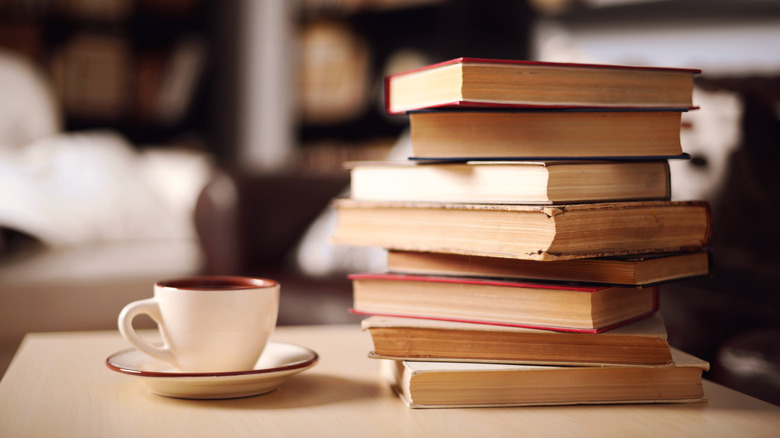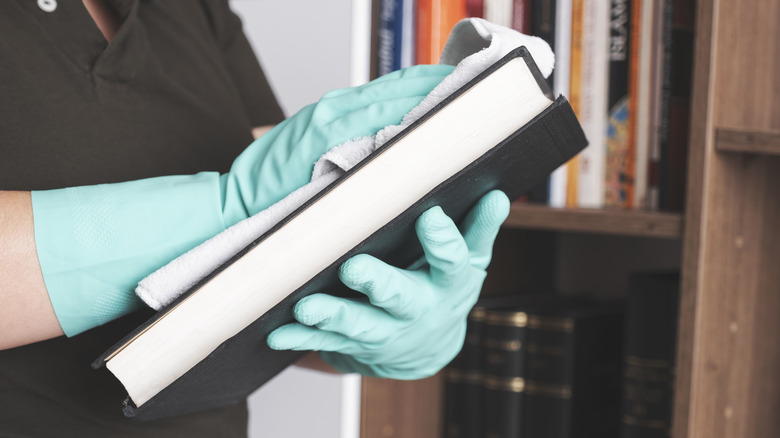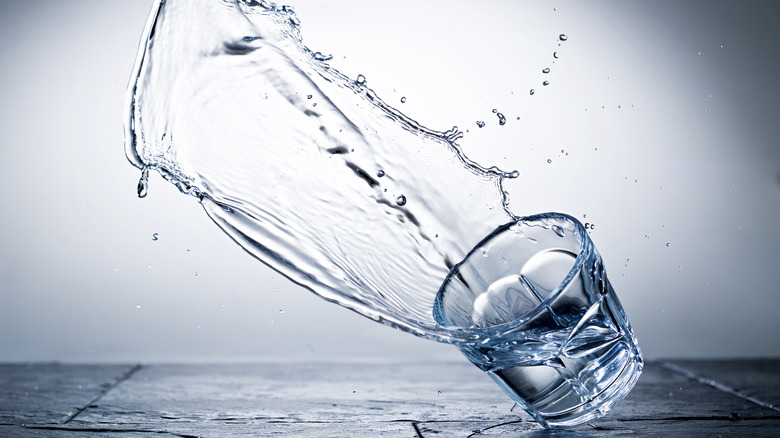How To Properly Clean Your Coffee Table Books
If you like to keep a stack of books on your coffee table, you likely know how quickly your collection can fall victim to a misplaced mug of coffee or airborne food particles. Unfortunately, your reading material can also gather dust, especially if your to-be-read pile keeps growing. Luckily, there are a few easy ways to keep the volumes decorating your table looking great.
For routine cleaning, it's best to dust your books' covers, tops, and bottoms using a microfiber cloth or a duster. If the covers are smeared in smudges from sticky fingers, there's a fix for that, too. "To remove a smudge from a book, use an art gum eraser," Leanne Stapf, Chief Operations Officer of The Cleaning Authority, told MarthaStewart.com. "Make sure you only use it in one direction only." If that doesn't work, Stapf suggests dabbing the area with a cloth moistened with rubbing alcohol. However, while these methods are great for most tomes, leather-bound covers should be cleaned with a leather cleaner.
Stapf also has recommendations for books that have developed an unpleasant odor. "A simple quick fix is putting an open box of baking soda into an airtight container, then placing your book on top and closing the container ... let it sit for a few hours or overnight to allow the baking soda to remove any odors," Stapf explains.
Getting stains out of books
Stains from spilled drinks or food on pages or paper covers can be tricky to clean, but that doesn't mean the damage is irreparable. If the stain is water-based, carefully wet it with a few drops of water, add a drop of dish soap to a dampened microfiber cloth, and gently rub the stain. If this isn't enough to get it out, you can try using a small amount of rubbing alcohol and a paper towel.
If you like to eat at your coffee table, you may get oil on your books. "To remove grease stains from a paper surface, mix equal parts water and vinegar, then take a cotton ball or swab and dab into the mixture," Stapf explains (via MarthaStewart.com). She suggests letting the solution sit for 10 minutes with a weight on top so the page can absorb the vinegar. If the stain doesn't come out immediately, repeat the process. Once the stain is gone, the page will likely sport wrinkles from being wet. You can use an iron to smooth the page, but be careful not to burn it.
Did ripping off a sticker mar the back cover of your favorite coffee table book? To remove the pesky adhesive left behind by stickers, heat the area with a hair dryer, ensuring the book doesn't get too hot, and the residue should be easy to scrape off.
Dealing with water damage
While it may seem like irreversible damage, you can save coffee table books that have become soaked due to a spilled glass of water. First, use a clean cloth to remove as much moisture as possible. "Then stand the book up and separate out the pages to fan out any additional moisture," Stapf tells MarthaStewart.com. "You can also place pieces of dry cloth or paper towels between each page to help soak up any moisture that remains." Once your book starts drying, carefully spread a little cornstarch over the worst areas and set it in front of a fan. This should prevent mildew from forming.
While mildew can ruin a coffee table book, small areas can be spot cleaned with hydrogen peroxide and vodka, according to Melissa Poepping, founder of The Chemical Free Home. If the mildew is dry, it will be easier to clean. "Place an absorbent soft cloth under the page, and gently dab the area of concern with the liquid solution," Poepping explains (via MarthaStewart.com). "Once dry, assess the page and repeat if necessary."
If the cover of your book has a small moldy area, an old toothbrush can likely be used to remove it. Then apply denatured alcohol using a gentle cloth. To remove mold from pages, dab affected areas with a cloth dampened with hydrogen peroxide, then allow the pages to dry.


